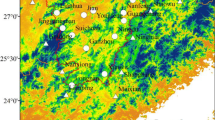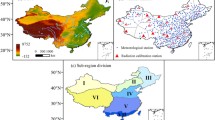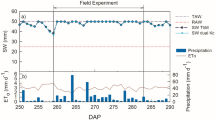Abstract
Based on data collected from rice fields under drying–wetting cycle condition, the procedure of dual-crop coefficient (K cd) approaches was calibrated and validated to reveal its feasibility and improve its performance in rice evapotranspiration (ET c) estimation. It was found that K cd based on FAO-recommended basal crop coefficients (K cb) underestimated dual-crop coefficients in monsoon climate region in East China. The recommended coefficient (K cp) value of 1.2 was not high enough to reflect the pulse increase of rice ET c after soil wetting. The K cb values were calibrated as 1.52 and 0.63 in midseason and late season, and the K cp value was adjusted as 1.29 after soil wetting in rice field under drying–wetting cycle condition. The dual-crop coefficient curves based on locally calibrated K cbCal and K cpCor matched well with the measured crop coefficients and performed well in calculating rice evapotranspiration from paddy fields under drying–wetting cycle condition. So it can be concluded that the procedure of dual-crop coefficient method is feasible in rice ET c estimation, and locally calibrated K cb and K cp can improve its performance remarkably.










Similar content being viewed by others
Abbreviations
- ET c :
-
Crop evapotranspiration, mm d−1
- ET 0 :
-
Reference crop evapotranspiration, mm d−1
- ET cMea :
-
Daily crop evapotranspiration by water balance calculation based on field measurement, mm d−1
- K cs :
-
Single-crop coefficients
- K cd :
-
Dual-crop coefficients
- K cdMea :
-
Measured dual-crop coefficients
- K cb :
-
Basal crop coefficients
- K e :
-
Soil evaporation coefficients
- K s :
-
Soil moisture deficit coefficient
- NFI:
-
Non-flooding controlled irrigation
- FL:
-
Field groundwater level
- CL1:
-
Controlled subsurface drainage level 1
- CL2:
-
Controlled subsurface drainage level 2
- K cbTab :
-
Tabulated basal crop coefficient following the FAO 56 procedure
- K cbAdj :
-
Adjusted basal crop coefficient
- K cbCal :
-
Locally calibrated basal crop coefficient
- K cp :
-
Coefficient recommended by FAO
- K cpCor :
-
Corrected K cp
- ini:
-
Initial
- mid:
-
Midseason
- end:
-
Late season
References
Abrisqueta I, Abrisqueta JM, Tapia LM, Munguía JP, Conejero W, Vera J, Ruiz-Sánchez MC (2013) Basal crop coefficients for early-season peach trees. Agric Water Manag 121:158–163
Alberto MCR, Quilty JR, Buresh RJ, Wassmann R, Haidar S, Correa TQ, Sandro JM (2014) Actual evapotranspiration and dual crop coefficients for dry-seeded rice and hybrid maize grown with overhead sprinkler irrigation. Agric Water Manag 136:1–12
Allen RG, Pereira LS (2009) Estimating crop coefficients from fraction of ground cover and height. Irrig Sci 28:17–34
Allen RG, Pereira LS, Raes D, Smith M (1998) Crop evapotranspiration: guidelines for computing crop requirements, irrigation and drainage paper no 56. Food and Agriculture Organization of the United Nations, Rome
Allen RG, Pereira LS, Smith M, Raes D, Wright JL (2005) FAO-56 dual crop coefficient method for estimating evaporation from soil and application extensions. J Irrig Drain E-ASCE 131:2–13
Arif C, Toriyama K, Nugroho BDA, Mizoguchi M (2015) Crop coefficient and water productivity in conventional and system of rice intensification (SRI) irrigation regimes of terrace rice fields in Indonesia. J Teknol 75(17):97–102
Bouman BAM, Lampayan RM, Tuong TP (2007) Water management in irrigated rice: coping with water scarcity. International Rice Research Institute (IRRI), Los Baños
Choudhury BU, Singh A (2016) Estimation of crop coefficient of irrigated transplanted puddled rice by field scale water balance in the semi-arid Indo-Gangetic Plains, India. Agric Water Manag 176:142–150
Ding RS, Kang SZ, Zhang YQ, Hao XM, Tong L, Du TS (2013) Partitioning evapotranspiration into soil evaporation and transpiration using a modified dual crop coefficient model in irrigated maize field with ground-mulching. Agric Water Manag 127:85–96
FAOSTAT (2014) Food and Agriculture Organization of the United Nations. http://faostat3.fao.org/home/E
Ghamarnia H, Miri E, Ghobadei M (2014) Determination of water requirement, single and dual crop coefficients of black cumin (Nigella sativa L.) in a semi-arid climate. Irrig Sci 32:67–76
He YP, Yang SH, Xu J, Wang Y, Peng SZ (2014) Ammonia volatilization losses from paddy fields under controlled irrigation with different drainage treatments. Sci World J. doi:10.1155/2014/417605
Jiang XL, Kang SZ, Tong L, Li FS, Li DH, Ding RS, Qiu RJ (2014) Crop coefficient and evapotranspiration of grain maize modified by planting density in an arid region of northwest China. Agric Water Manag 142:135–143
Kashyapi A, Das HP, Hage AP, Kale AA (2009) A study on parameters controlling water requirement of rice (Oryza sativa L.) at various phenophases in different agroclimatic zones. Mausam 60(2):211–218
Kingra PK, Hundal SS, Sharma PK (2004) Characterization of crop coefficients for wheat and rice crops in Punjab. J Agrometeorol 6:58–60
Kuo SF, Ho SS, Liu CW (2006) Estimation irrigation water requirements with derived crop coefficients for upland and paddy crops in ChiaNan Irrigation Association, Taiwan. Agric Water Manag 82(3):433–451
Lage M, Bamouh A, Karrou M, EI Mourid M (2003) Estimation of rice evapotranspiration using a microlysimeter technique and comparison with FAO Penman-Monteith and Pan evaporation methods under Moroccan conditions. Agronomie 23(7):625–631
Lazzara P, Rana G (2010) The use of crop coefficient approach to estimate actual evapotranspiration: a critical review for major crops under Mediterranean climate. Ital J Agrometeorol 15(2):25–39
Li DX, Peng SZ, Ding JL, Xu JZ, Yu JY (2008) Laboratory calibration on measurement of field soil moisture using TDR. Agric Res Arid Area 26(1):249–252 (In Chinese)
Liu YJ, Luo Y (2010) A consolidated evaluation of the FAO-56 dual crop coefficient approach using the lysimeter data in the North China Plain. Agric Water Manag 97(1):31–40
Lopez-Urrea R, Olalla FMD, Montoro A, Lopez-Fuster P (2009) Single and dual crop coefficients and water requirements for onion (Allium cepa L.) under semiarid conditions. Agric Water Manag 96(6):1031–1036
Madramootoo CA, Johnston WR, Willardson LS (1997) Management of agricultural drainage water quality. Food and Agriculture Organisation, New Delhi
Mao Z, Li YH, Li HC (1995) Study of mathematic model for forecasting daily crop evapotranspiration. J Wuhan Univ Hydraul Electr Eng 28:253–259 (In Chinese)
Martins JD, Rodrigues GC, Paredes P, Carlesso R, Oliveira ZB, Knies AE, Petry MT, Pereira LS (2013) Dual crop coefficients for maize in southern Brazil: model testing for sprinkler and drip irrigation and mulched soil. Biosyst Eng 115(3):291–310
Mohan S, Arumugam N (1994) Irrigation crop coefficients for lowland rice. Irrig Drain Syst 8(3):159–176
Moratiel R, Martinez-Cob A (2013) Evapotranspiration and crop coefficients of rice (Oryza sativa L.) under sprinkler irrigation in a semiarid climate determined by the surface renewal method. Irrig Sci 31(3):411–422
Paco TA, Ferreira MI, Rosa RD, Paredes P, Rodrigues GC, Conceicao N, Pacheco CA, Pereira LS (2012) The dual crop coefficient approach using a density factor to simulate the evapotranspiration of a peach orchard: SIMDualKc model versus eddy covariance measurements. Irrig Sci 30(2):115–126
Peng SZ, He YP, Yang SH, Xu JZ (2015) Effect of controlled irrigation and drainage on nitrogen leaching losses from paddy fields. Paddy Water Environ 13:303–312
Pereira LS, Allen RG, Smith M, Raes D (2015) Crop evapotranspiration estimation with FAO56: past and future. Agric Water Manag 147:4–20
Poblete-Echeverria CA, Ortega-Farias SO (2013) Evaluation of single and dual crop coefficients over a drip-irrigated Merlot vineyard (Vitis vinifera L.) using combined measurements of sap flow sensors and an eddy covariance system. Aust J Grape Wine Res 19(2):249–260
Shah SB, Edling RJ (2000) Daily evapotranspiration prediction from Louisiana flooded rice field. J Irrig Drain E-ASCE 126(1):8–13
Shahrokhnia MH, Sepaskhah AR (2013) Single and dual crop coefficients and crop evapotranspiration for wheat and maize in a semi-arid region. Theor Appl Climatol 114(3–4):495–510
Sheng P, Xu K, Wu Q, Wu F (1998) Experimental study on suitable water table depth of main crops in Shanghai suburbs. Shanghai Agric Sci Technol 5:2–5 (In Chinese)
Shrestha NK, Shukla S (2014) Basal crop coefficients for vine and erect crops with plastic mulch in a sub-tropical region. Agric Water Manag 143(143):29–37
Traore S, Wang YM, Kan CE, Kerh T, Leu JM (2010) A mixture neural methodology for computing rice consumptive water requirements in Fada N’Gourma Region, Eastern Burkina Faso. Paddy Water Environ 8(2):165–173
Turner NC (2006) Preface (Special issue on water scarcity: challenges and opportunities for crop science). Agric Water Manag 80:1–3
Tyagi NK, Sharma DK, Luthra SK (2000) Determination of evapotranspiration and crop coefficients of rice and sunflower with lysimeter. Agric Water Manag 45(1):41–54
Vu SH, Watanabe H, Takagi K (2005) Application of FAO-56 for evaluating evapotranspiration in simulation of pollutant runoff from paddy rice field in Japan. Agric Water Manag 76(3):195–210
Wei Z, Paredes P, Liu Y, Chi WW, Pereira LS (2015) Modelling transpiration, soil evaporation and yield prediction of soybean in North China Plain. Agric Water Manag 147:43–53
Xu JZ, Peng SZ, Yang SH, Wang WG (2012) Ammonia volatilization losses from a rice paddy with different irrigation and nitrogen managements. Agric Water Manag 104:184–192
Xu JZ, Peng SZ, Ding JL, Wei Q, Yu YM (2013) Evaluation and calibration of simple methods for daily reference evapotranspiration estimation in humid East China. Arch Agron Soil Sci 59(6):845–858
Yang XG, Bouman BAM, Zhang QP, Xue CY, Zhang TY, Xu JY, Wang P, Wang HQ (2006) Crop coefficient of aerobic rice in North China. Transactions of the CSAE 22(2):37–41 (In Chinese)
Yang SH, Peng SZ, Xu JZ, He YP, Wang YJ (2015) Effects of water saving irrigation and controlled release nitrogen fertilizer managements on nitrogen losses from paddy fields. Paddy Water Environ 13(1):71–80
Yoo SH, Choi JY, Jang MW (2006) Estimation of paddy rice crop coefficients for Penman-Monteith and FAO modified Penman method. ASABE Annual International Meeting, Portland
Zhang BZ, Liu Y, Xu D, Zhao NN, Lei B, Rosa RD, Paredes P, Paco TA, Pereira LS (2013) The dual crop coefficient approach to estimate and partitioning evapotranspiration of the winter wheat-summer maize crop sequence in North China Plain. Irrig Sci 31(6):1303–1316
Zhao NN, Liu Y, Cai JB, Paredes P, Rosa RD, Pereira LS (2013) Dual crop coefficient modelling applied to the winter wheat-summer maize crop sequence in North China Plain: basal crop coefficients and soil evaporation component. Agric Water Manag 117:93–105
Acknowledgments
This research was financially supported by the National Natural Science Foundation of China (No. 51179049), Innovative Young Scholar Project of State Key Laboratory of Hydrology-Water Resources and Hydraulic Engineering (No. 20145027912), Advanced Science and Technology Innovation in Colleges and Universities in Jiangsu Province, and a project funded by the Priority Academic Program Development of Jiangsu Higher Education Institutions.
Author information
Authors and Affiliations
Corresponding author
Rights and permissions
About this article
Cite this article
Xu, J., Lv, Y., Ai, L. et al. Validation of dual-crop coefficient method for calculation of rice evapotranspiration under drying–wetting cycle condition. Paddy Water Environ 15, 381–393 (2017). https://doi.org/10.1007/s10333-016-0556-9
Received:
Revised:
Accepted:
Published:
Issue Date:
DOI: https://doi.org/10.1007/s10333-016-0556-9




